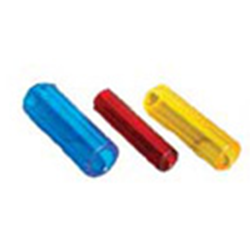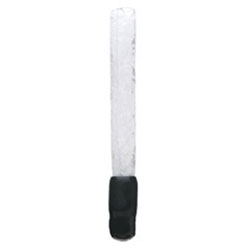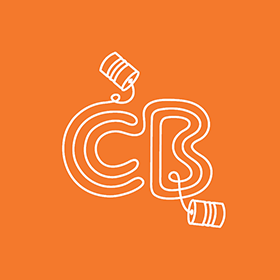The second part of Sam’s treatment for vowels was the speech production or articulation portion. We began by targeting the round vowels such as /Ʊ/. A lesson plan was created that included auditory bombardment, production of the sound in isolation with PROMPT and tactile cues, production of the sound in words using a functional or communication task, and production of the sound in a word using drills.
For the round vowels multiple tactile cues were provided to elicit the lip rounding. The TalkTools Tactile Tubes were particularly helpful. Since they come in different diameters, different tubes were used to elicit different sounds. Initially the use of Renee R. Hill’s and Sara R. Johnson’s Ice Stick was also very helpful to elicit lip rounding. The added thermal stimulation provided by the cold Ice Stick yielded some good results. The Ice Stick placed horizontally was used to elicit lip retraction for vowels such as /i/. In addition, two Bite Blocks placed between the molars simultaneously on both sides also assisted with stabilizing the jaw height while aiding lip retraction.
Following the principals of Hodson and Paden’s Cycle’s Approach, a vowel was targeted for a few weeks and then a new vowel was selected. Once all the sounds were targeted, the same targets were then re-cycled. The functional or communication tasks were the highlight of the session. This portion is important since it gives us as therapists the opportunity to shape the sound in one phonetic context using multiple trials. For example, when targeting the “ee” sound, I used the Honey Bee Tree game. I worked on the words “tree” and “leaf” when Sam placed the leaves on the tree. When he pulled the leaves out and the bees fell, I targeted the word “bee.” I try to elicit the word at least 8-10 times per activity. In a half hour session, I try to include at least 4-5 similar communication activities. Apart from being able to target the same word through multiple repetitions, the communication task also gives the child an opportunity to use the sound in a meaningful way rather than simply naming pictures in a drill.
As a part of the generalization portion of the lesson, I would have Sam’s parent lead one of the activities in the clinic (so Sam can produce the target word with a person other than me) and I also provided the parents with a copy of the drill pictures to practice at home.
 Once Sam’s tactile defensiveness was significantly reduced, my next goal was to stabilize his jaw and increase jaw grading (i.e. opening and closing of his mouth to various jaw heights without jaw sliding or jerking). Since Sam tended to “fix” his jaw at jaw height 1 (closed mouth position) during speech, my objective was to move him gradually through Sara R. Johnson’s Bite Block hierarchy. Unless Sam was able to lower his jaw to jaw height 3 or 4, production of vowels such as /Ɔ/ would be challenging. We started with Bite Block #2 and within several weeks were able to move to Bite Block #6, which requires considerable jaw opening. Sam can now hold a lower jaw position without sliding. As a part of a comprehensive oral motor or oral placement program, we also worked on lip rounding, lip seal and tongue retraction. Sara R. Johnson’s Horn and Straw Hierarchy’s were employed for this purpose. In addition, a tongue depressor with added “weights” (pennies taped to both ends) were used to build lip strength and lip closure.
Once Sam’s tactile defensiveness was significantly reduced, my next goal was to stabilize his jaw and increase jaw grading (i.e. opening and closing of his mouth to various jaw heights without jaw sliding or jerking). Since Sam tended to “fix” his jaw at jaw height 1 (closed mouth position) during speech, my objective was to move him gradually through Sara R. Johnson’s Bite Block hierarchy. Unless Sam was able to lower his jaw to jaw height 3 or 4, production of vowels such as /Ɔ/ would be challenging. We started with Bite Block #2 and within several weeks were able to move to Bite Block #6, which requires considerable jaw opening. Sam can now hold a lower jaw position without sliding. As a part of a comprehensive oral motor or oral placement program, we also worked on lip rounding, lip seal and tongue retraction. Sara R. Johnson’s Horn and Straw Hierarchy’s were employed for this purpose. In addition, a tongue depressor with added “weights” (pennies taped to both ends) were used to build lip strength and lip closure.

